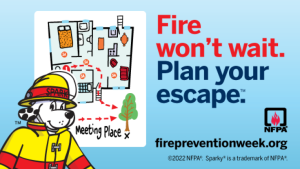 October 9-15, 2022 is Fire Prevention Week. This year is 100th anniversary of Fire Prevention Week. Starting in 1922, FPW has been sponsored as a public observance by the NFPA. President Calvin Coolidge proclaimed Fire Prevention Week a national observance in 1925, making it the longest-running public health observance in our country.
October 9-15, 2022 is Fire Prevention Week. This year is 100th anniversary of Fire Prevention Week. Starting in 1922, FPW has been sponsored as a public observance by the NFPA. President Calvin Coolidge proclaimed Fire Prevention Week a national observance in 1925, making it the longest-running public health observance in our country.
During Fire Prevention Week, the focus is on educating the public about fire safety in order to decrease fire casualties. This year’s FPW theme is, “Fire won’t wait. Plan your escape.™”
FPW is observed during the week of October 9th in commemoration of the Great Chicago Fire which began on October 8, 1871. This fire killed more than 250 people, left 100,000 homeless, destroyed more than 17,400 structures, and burned more than 2,000 acres of land.
“Fire won’t wait. Plan your escape.™”
Home fires burn faster than ever. During a home fire, you may have as little as 2 minutes to safely escape the fire after the smoke alarm goes off. The safety of you and your loved ones depends on early warning from smoke alarm and advance planning. Plan and practice your home fire escape plan before a fire occurs. Make sure everyone in your household knows what to do. Children, older adults, and people with disabilities may need assistance to wake up and get out.
Action #1: Prepare Your Smoke Alarms
Your smoke alarms can sense smoke before you can. Make sure you have working smoke alarms in your home to keep your family safe.
- Test your smoke alarms by pushing the test button. If the alarm makes a loud beep, beep, beep sound, it is working. If there is no sound or the sound is quiet, replace the battery.
- If your smoke alarm is older than 10 years old, it should be replaced.
- Smoke alarms should be installed in every sleeping room, outside each sleeping area, and on every level of the home, including the basement.
- If your smoke alarm makes a “chirp,” that means it needs a new battery. Change the battery right away.
- Make sure everyone in your home knows the sound of the alarm and what to do when it sounds.
Action #2: Create & Practice Your Home Fire Escape Plan
Make a home fire escape plan so that everyone in your household knows what to do when fire occurs. You should practice your home escape plan twice a year.
- Draw a map of all the rooms in your home.
- Mark two exits from each room (usually a door and a window). Mark a path from each exit to the outside.
- Include the location of all smoke alarms in your home.
- Choose an outside meeting place in front of your home where everyone will meet upon exiting.
- Add “911” or the local emergency number to your plan.
- Plan to call that number from a neighbor’s phone or a cell phone once you get outside.
If you are interested in learning more about Fire Prevention Week and fire safety, visit the NFPA’s website.















